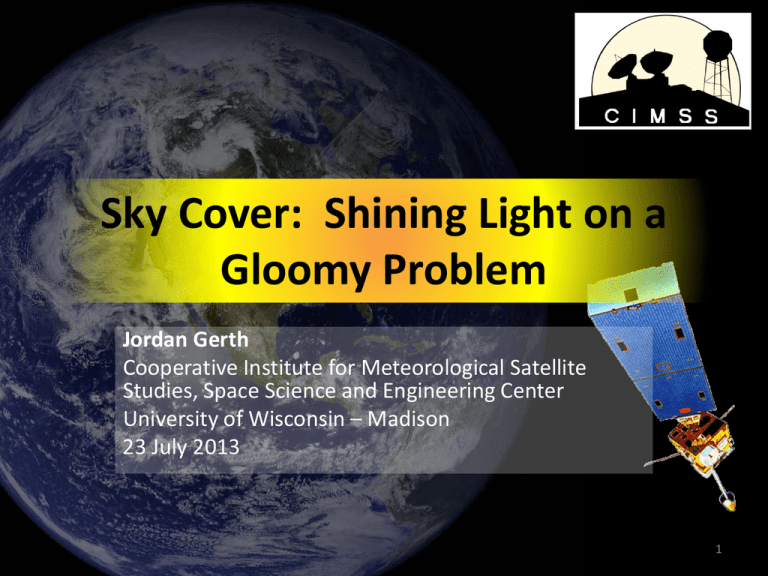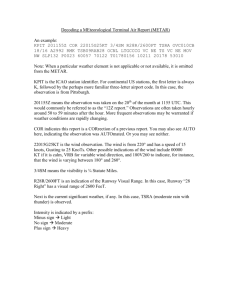Sky Cover: Shining Light on a Gloomy Problem
advertisement

Sky Cover: Shining Light on a Gloomy Problem Jordan Gerth Cooperative Institute for Meteorological Satellite Studies, Space Science and Engineering Center University of Wisconsin – Madison 23 July 2013 1 The Ultimate Problem Not a clear definition Poor instrumentation for observing high cloud Observers occasionally fail to correct it Meteorologists often neglect sky cover due challenges with other parts of the forecast • Numerical weather prediction models are grid based and cloud grids are often too bimodal • Satellites see the tops of clouds, but not necessarily the surface sky cover • • • • 2 Defining Sky Cover The National Weather Service (NWS) web site defines “sky cover” as “the expected amount of opaque clouds (in percent) covering the sky valid for the indicated hour.” • No probabilistic component. • No definition of “opaque cloud” or “cloud”. • The implication is cloud coverage of the celestial dome (all sky visible from a point observer). 3 Forecasting Sky Cover The NWS’ National Digital Forecast Database (NDFD) contains the gridded operational forecast for sky cover. Issues with the national one-hour forecast include: – Clear areas with non-zero cloud cover – Vastly different cloud classifications for similar cloud scenes – Lack of spatial continuity between forecast areas – Temporal trends do not match observations 4 5 6 Observing Sky Cover • Geostationary satellites are helpful in assessing sky cover because of good – Spatial coverage (4 km) – Temporal continuity (15 minutes) • Effective cloud amount (or effective cloud emissivity) is a close proxy to sky cover, with some exceptions • Satellites observe cloud top-down (high cloud first), humans see bottom-up (low cloud first). 7 The GOES Imager Effective Cloud Amount (ECA) is the standard effective cloud emissivity product from the GOES Imagers, valid at the indicated time. 8 The GOES Imager Celestial Dome ECA is an average of the standard effective cloud emissivity within a box of 11 by 11 pixels, centered on each grid point, valid at the indicated time. 9 The GOES Imager Sky Cover Product is a time-average of the celestial dome ECA within a onehour window. The valid time begins at the time indicated on the plot. The average is all scans after the valid time, within one hour. 10 Surface Observations • These are all sky observations taken from surface stations. • The fractional cloud cover from each observation is converted from the reported cloud type in the METAR. • Multiple observations within a one-hour window following the valid time, and/or within 10 km, are averaged. Reported Coverage Assigned Value Clear 0% Scattered 40% Broken 75% Overcast 100% Obscured 100% Thin Scattered 25% Thin Broken 60% Thin Overcast 90% KMKE 230052Z 17007KT 10SM FEW050 SCT095 BKN250 26/20 A2973 RMK AO2 SLP062 T02560200 11 12 13 Blended Sky Cover Analysis For a given point: • If satellite sky cover product or surface observation analysis indicates a clear sky, the blended sky cover analysis value is clear. • If the surface observation analysis is higher than the satellite sky cover product, the surface observation analysis value is used. • Otherwise, the two measurements are blended with a weight depending on the distance to the nearest non-clear surface observation. 14 15 Optimal Sky Cover Analysis • Uses a linear solver to minimize the mean absolute difference between the blended sky cover analysis and the NDFD one-hour forecast, subject to some constraints, for a selected set of points. • The main constraint is that the piecewise linear function must be continuous, and that the minimum (0) and maximum (100) values must be anchored. 16 The GOES Imager Optimal Sky Cover is a linear optimization of the sky cover product, intended to minimize absolute error when compared the National Digital Forecast Database (NDFD) one-hour forecast. The valid time and range coincides with the sky cover product. 17 18 Optimizing Sky Cover • Model output can be optimized to produce the desired quantity. • In this case, the objective is to decrease the mean absolute difference between the optimal sky cover analysis and a linear sum of model variables subject to coefficients and scalars applied to non-zero mixing ratios. • The coefficients are further constrained by a tolerance constraint on the mean value. 19 Optimizing Sky Cover Variables used: – Relative Humidity (all levels) – Cloud Water Mixing Ratio, Rain Water Mixing Ratio, Snow Mixing Ratio (all levels) – Absolute Vorticity (200 hPa only), partitioned into positive and negative components • Pressure levels used: – – – – – – – – – 200 hPa 300 hPa 500 hPa 700 hPa 800 hPa 850 hPa 900 hPa 950 hPa 1000 hPa 20 21 The High-Resolution Rapid Refresh (HRRR) Total Cloud Cover is the model output cloud cover from the analysis of the run initiated at the valid time. 22 23 24 Conclusions • Current effort is focusing on producing three-, six-, and nine-hour forecasts of sky cover from the HRRR using the output from the optimization model • Linear optimization may yield fruit in the investigation of other problems in the atmospheric sciences where: – Multiple optimized quantities are required – A relationship between the optimized quantities is understood – Quantities are subject to constraints relative to each other or supported by the science • Questions? Comments? Jordan.Gerth@noaa.gov 25







